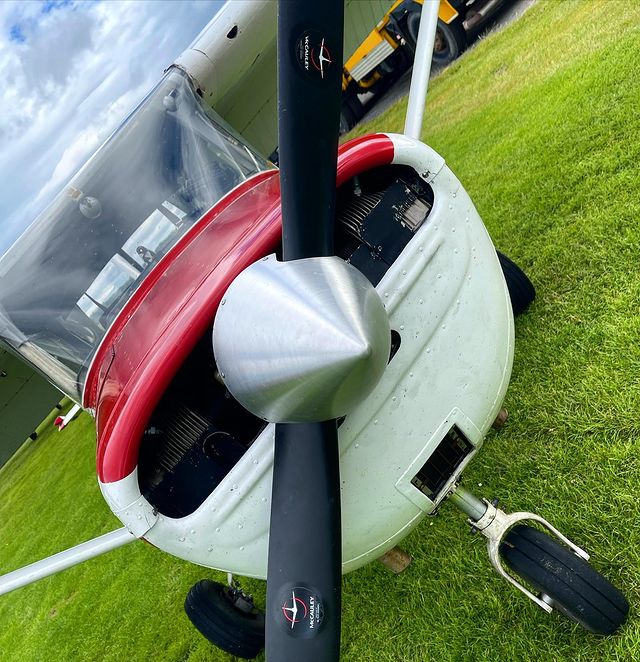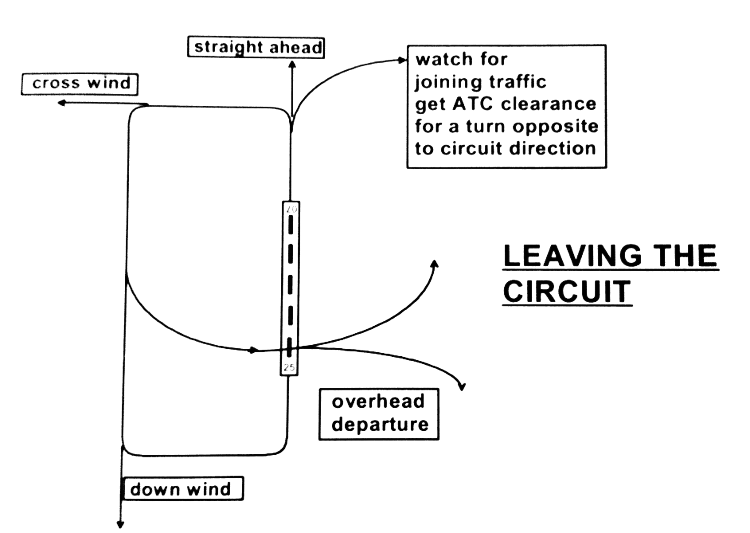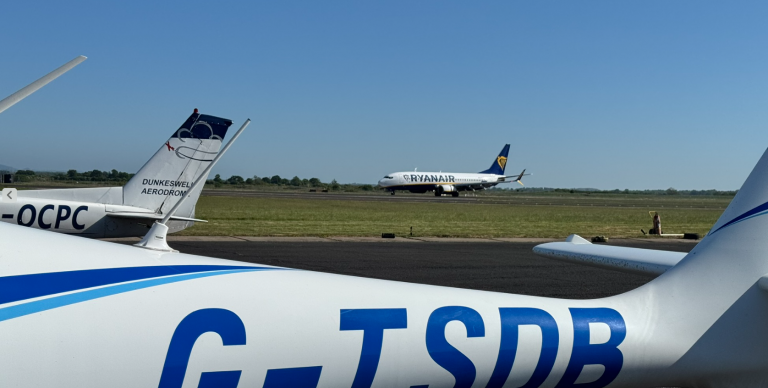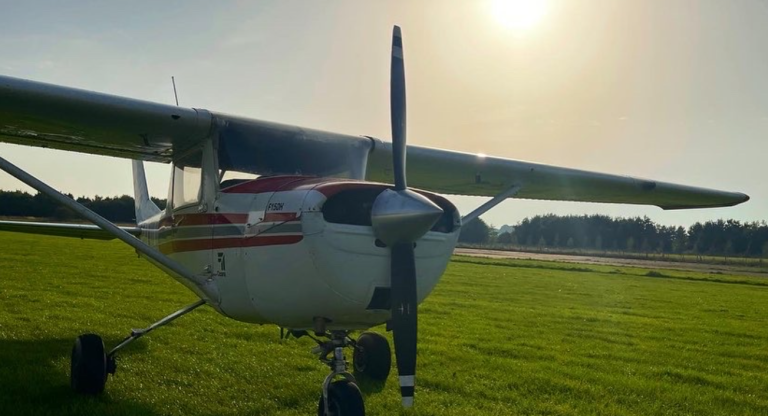
“We’re doing stalls today,” said my instructor.
This was the lesson I’d dreaded the most. Being a plane geek for years, I could recite many crashes from stalls over the years. One stuck in my head as the briefing began – the tragic accident involving an Air France A330 over the South Atlantic ocean.
After the briefing my instructor asked me to head out to the plane, do the external checks and start the engine – all by myself!
Pre-Start Checklists
I ran the full external check checklist, dipped the oil and took a sample of fuel which was clear of contamination and glowed a translucent sky blue in the morning sun, indicating it was avgas, the correct fuel for the Cessna.
I hopped into the aicraft and ran the internal checklist, halfway through I spotted my instructor standing just outside the clubhouse patiently waiting for me to finish.
“Clear prop!” I yelled out the door before turning the key to activate the starter motor, and the new McCauley propeller spun into life. It was the first time I’d sat in an aircraft all alone with the engine turning – a taste of what a solo flight would feel like. It was exhilarating!
With my toes forward on the toe brakes so the 150 didn’t move – the parking brake was broken (“inop” – short for inoperable) – my instructor walked over and, being careful to avoid the prop, went around the tail before jumping into the right seat.
I made a call on the radio asking for a radio check and alerting all aircraft on the frequency I planned to “backtrack runway 19 to Charlie.”
The airfield as an Air-to-Ground-Communication-System (AGCS) but this is not guaranteed to be manned, and usually isn’t when I’ve flown previously, so I was a little surprised when the reply came back, “Uniform-Juliet, readability 5!”. The scale is 1-5 and 5 is the best, so our radio was working at least!
I taxiied across the grass and crossed runway 19G which I mentioned in the last lesson, before entering the paved runway 01/19 to backtrack to holding point Charlie (C).
I stopped aircraft and got a front row seat to another single-engine piston aircraft do a touch-and-go (landing, then going to full power to take off straight away without stopping).
We waited for the other aircraft to become airborne and fly clear of the runway – bear in mind that if a small aircraft has an engine failure just after take off (known as an EFATO) it often has enough runway left to land again safely on the same runway. Runway 26 is actually quite short so impractical to do this but it is a good habit to stay clear anyway in case a pilot with an emergency decides to try!
I expected to be instructed to backtrack runway 26 (the runway ‘in use’), however, my instructor radio’d that we’d be taking off runway 19 for crosswind take off practice. An affirmative reply came back from the aircraft in the pattern.
I ran the pre-takeoff checks:
- RPMs to 1700
- Check magnetos on Both
- Pull carb heat out to heat the engine – check RPMs drop – carb heat back to cold
- Check left and right magnetos for dead-cut, then switch back to Both
- Pull throttle all the way to idle to check for idle-cutoff (see lesson 1 for more info)
- Finally, throttle back to 1200rpm
We looked at the approach for runway 26 (not all light aircraft have radios) to make sure it was clear and taxiied slightly onto 26 for extra runway, before powering down 19.
Takeoff
When the ASI (air speed indicator) twitched, I ran through the take off checks, calling out “airspeed alive, T’s and Ps in the green, RPM stable…. and 50 knots” – all while gradually turning the control wheel back to neutral, before taking off.
At 300ft above airfield level (aal) I pulled the flaps up, at 500ft I turned onto crosswind, and at 1,000ft but still climbing I turned back over towards the airfield with a radio call, “Uniform Juliet leaving the circuit to the north east, changing frequency to Scottish Information 119.875.”

This convention allows any traffic who still needs to contact you to know which frequency you’re going to be on. Once we’d passed 1,500ft we were safely above pattern altitude and the other aircraft would remain below us practising touch and goes.
Stalling an Aircraft (On Purpose!)
After a few minutes of flying we ran the HASELL checks:
- H – Height – is there a sufficient amount of height from the ground to recover from the stall? 3,000ft is typical for starting stalls at. We were a little lower today due to the cloudbase.
- A – Airframe – is the airframe in the correct configuration, e.g. are flaps up if you are performing a ‘clean’ stall?
- S – Security – is anything that may be loose in the cockpit tied down or put away?
- E – Engine – are all the engine indications healthy? Ts & Ps in the green, mixture rich, no warning lights, ammeter charging, suction, etc.
- L – Location: are we clear of “ABCCD”:
- A – Active airfields
- B – Built up areas
- C – Cloud
- C – Controlled airspace
- D – Danger areas
- L – Lookout – before doing a stall, it’s important to have a full look around to ensure you have good situational awareness (SA) and you’re not going to be in the way of any air traffic. This is usually done by performing a single 180degree turn, or two 90degree turns, these are called “clearing turns”.
Once I’d performed the HASELL checks and two 90deg clearing turns (a left turn to the west, then a right back to the north) my instructor said, “I have control,” and ran through the first stall. This one, he said, would be a “fully developed stall”, and I’d build up to that afterwards.
Nervously, I sat politely in my seat wondering what a “full stall” would be like and why I’d paid a lot of money for the pleasure of experiencing one!
He pulled the carb heat out to heat the engine that would be about to run at low power for a few minutes, pulled the throttle back to idle and raised the nose… and raised the nose… and raised the nose. It felt like we were pointing straight up.
I watched the airspeed indicator needle fall, 60… 50…
At 45 knots indicated airspeed (IAS), the stall warning squeaked before becoming a continuous sound. At 40 knots IAS the aircraft began to wobble in the air as the wings fought a losing battle to maintain airflow over them and keep providing lift. Some people say the airframe “shakes” but I haven’t found it to be that severe, wobbling is much closer to it.
Now, to quickly explain some things that are going on. Firstly, training aircraft are quite safe to stall as long as you know the correct recovery sequence, which we’d covered in the brief earlier. Secondly, stalls are rarely symmetrical because the propeller spinning introduces asymmetrical forces to the wing, so the left wing usually stalls first, requiring right-aileron (turning right on the control column) to stay straight. Finally, the horizontal stabiliser actually provides a downward force when it has airflow over it, this means that in a stall situation, the horizontal stabiliser will also stall, relieving the downward pressure, and lowering the nose automatically, which will help recovery.
On this occasion (due to a gust of wind, we think) the right wing stalled first and my instructor caught it deftly, keeping the wings level. Then the nose dropped, signifying that the horizontal tailplane had stalled.
Stall recovery
Recovering from a stall is quite straightforward, the process is left-hand, right-hand, left-hand. Simple:
- Left hand – the most important thing is to unstall the wings, and the only way to do that is decrease the angle of attack (AOA) of the oncoming airflow, so push the nose down to change the centre of pressure on the wings.
- Right hand – While changing the AOA is a good start, it won’t get you back to a safe airspeed by itself, so with the right hand push the throttle smoothly back to full power. Once time allows, you push in the carb heat back to cold to give extra power.
- Left hand – finally, when your airspeed increases back to Vy speed, pull the nose up and start climbing back to the original altitude you were at.
After my instructor had completed the recovery, he handed control back to me. I ran through the steps to introduce a stall: carb heat hot, power to idle, nose up and up and up….
With the stall warning horn screaming again the left wing dropped a little, which I corrected with right aileron. “Recover,” said my instructor.
I released the pressure with my left hand and added a tiny bit of forward pressure to bring the nose down to level flight, I pushed the throttle in fully, and at 65 knots (Vy) I pulled the nose up again to climb. My instructor made a comment about it sounding a little quiet and that was my hint to also push in the carb heat!
We did another clean stall (i.e. no flaps extended), this time holding back the controls until the nose dropped before recovering, then we moved onto a turning stall.
I pulled out the carb heat and slid back the throttle, rolled the wings to 30 degrees of bank and pulled back on the controls. Aerodynamically, the effect is still the same: speed is traded for nose-up attitude. This time the stall warning came in much faster – at 50 knots. In a bank, the stall speed increases – i.e. the aircraft stalls at a faster speed.
As the aircraft isn’t rated for spins (which can happen if the stall is left to develop and there is power on) we recovered at the first sign of the turning stall.
Recovery is exactly the same at the clean straight and level stall but that’s why it’s a bit weird – many pilots try to level the wings before pushing the nose forward, but as recovery is all about adjusting the AOA, pushing forward while still banked is the first manoeuvre, rolling level comes later.
Recovery from a turning clean stall:
- Push the control column forward
- Push the throttle forward to full
- Only then, roll wings-level
- As speed reaches Vy speed, climb to recover lost altitude
- At some point, don’t forget your carb heat!
We did a few more of these, flying around clouds in a scattered layer at 3,000ft.
Joining Straight In
Once I had clean and turning stalls down, I flew down the amazing Northumberland coast until Amble, the friendliest port, according to their signage, was under my left wing and turned inland towards the airfield for another first – a straight-in join to runway 26.
I’ve done overhead joins a few times, this technique is used when you need to find out for yourself which runway is in use – either by looking at the wind sock (it’s best to land into the wind) or seeing which runway other air traffic are using. This time we didn’t need to.
As we switched to the airfield radio frequency we heard that another aircraft was already using runway 26. The general rule is that any traffic already in the pattern dictates the active runway for all other traffic, so – while we took off into the wind on runway 19, we’d be landing with a crosswind on runway 26.
When you learn to fly, approaches are usually short because you land from within the pattern, on this occasion we had 5km or more to line up, configure for the approach and landing, and wait while the earth slowly rotated under our aircraft.
It took aaaaaaaages. I lined up and maintained 1,500ft above the ground (QFE) (500ft above pattern altitude as we hadn’t become visual with the aircraft in the pattern), waiting for the right moment to start descending towards the runway.
Then I had my first really scary moment in my training.
I pulled the throttle back to reduce our speed and start our approach towards the runway. I was just about to make a radio call alerting the other traffic that we were “on final” but the other traffic beat me to it.
“Mike Alpha, final, runway 26.”
My heart skipped a beat, my instructor and I started scanning the air around the airfield for the aircraft.
There’s always a risk in high-winged aircraft (like the Cessna I fly) that you crash into something above you, because your view above is blocked. The reverse is true for low-winged aircraft like the Piper PA28. As we’d just descended from above pattern height I was sure we weren’t going to get an aircraft through the roof.
But, there was a chance we could crash into the top of another high winged aircraft if it were directly under us.
“Add another notch of flaps,” said my instructor, and I did.
Flaps add drag, reduce your stall speed and allow you to fly straight and level with your nose pointed more towards the ground. This would help us see.
“He’s there, just landing.” My eagle eyed instructor pointed towards the threshold of the runway where a tiny aircraft shaped speck was touching down.
Phew!
I pushed the radio transmit button, “Uniform Juliet final runway 26, visual with the landing traffic.”
The speck rolled down the runway before lifting off again.
I added a bit of extra power to overcome the additional drag from the flaps and continued the approach, rather deftly (if I do say so myself) avoiding a large piece of farm machinery that a farmer, who didn’t like the airfield and the noise it brought to his farm, had left sticking up just short of the runway threshold.
I pulled the throttle to idle then the control column back to arrest the descent and held the aircraft off the runway, keeping it straight with a little bit of gentle dancing on the rudder pedals.
The main wheels softly kissed the runway and I carefully lowered the nosewheel onto the runway to find we were perfectly on the centreline – my best landing yet!
“Full power!” said my instructor, indicating he wanted this to be a touch and go.
Full of smugness and with a head that could be visible from the surface of Mars with the naked eye, I took the Cessna back into the air.
I’ve said this before but it’s true and it bears repeating: aviation has a way of sucker-punching the cockiness out of you.
Two Mistakes
I raised the flaps, turned onto crosswind, climbed back up to pattern altitude and then onto downwind. Looking out the left window to ensure we were on a parallel downwind with 26 I suffered a terrible brain-fart.
I thought I’d get in with a radio call before my instructor said a word, “Uniform Juliet, right downwind runway 26.”
Revelling in the warm endorphin glow of the landing my brain forgot which way was left and right.
This is very dangerous. The radio call is required to help other pilots build a mental picture of the traffic around the airfield, and my radio call made it sound like we were to the north of the airfield when we were really to the south.
“Uniform Juliet, correction, left downwind runway 26,” said my instructor quickly.
I apologised for the egregious error.
Having been taken down a peg, I decided to just focus on the landing.
“Mike Alpha, final runway 26,” said the other aircraft in the pattern as I waited until we were just past a road and before the east coast main line train tracks (it’s all about visual reference points!) before turning onto base (pointing at the golf ball radome overlooking Alnwick) and configuring for landing:
- reduce power to 1700rpm
- hold the nose up to let the speed bleed off
- once airspeed is in the white arc, lower the flaps
- at 65 knots, lower the nose and maintain that airspeed with pitch
I’ve found that doing all of this on the base leg makes for less busy final approaches, and ultimately better landings.
I turned left onto final, checked in my mind that what I was about to say on the radio was correct, and then transmitted, “Uniform Juliet, final runway 26.”
The approach, although much shorter than the first, was right on profile, and I didn’t need to do very much during the descent towards the runway – except for a little bit of dodging over the farm machinery.
Once clear of the obstacle, I pulled the power right back, raised the nose and kept the far end of the runway centred in the windscreen. Again, the main wheels touched down softly and we were bang on the centreline.
Inviting an error, my inner pride began to grow.
“Pull into Charlie,” said the instructor. (Btw, I’ve not mentioned to him that I’m writing up all my lessons – I’m mostly doing this to help embed the learnings in my brain – so I’ve not asked permission to identify him, hence all the “my instructor” vagueness!).
I rolled to the end of the runway without using the brakes, as there is generally enough friction from the tyres rolling to slow you down enough. I’ve developed a little routine of pulling back a little on the controls to hoist the elevators up into the airflow, acting as an airbrake, which helps too.
At the end of the runway I pulled off and into holding point Charlie. I grabbed the checklist and was about to do the after-landing checklist when my instructor said, “I have control.”
“You have control,” I said, curious as to what we were doing.
He taxied the Cessna back up (i.e. backtracked) runway 26. “You’re going to do an aborted take off, full power, do your checks, and as if something wasn’t right, you’re going to close the throttle, NO BRAKES, just let the aircraft slow down itself. No brakes.”
At the end of the runway he spun it a full 180 degrees so we were sat as if to take off. “You have control,” he said.
I smoothly pushed the throttle fully open with a count of 1-2-3, my right leg adding a bit of weight to the right rudder pedal almost entirely by itself to counter the yaw from the propeller.
“Airspeed alive, Ts & Ps in the green, RPM stable,” I called out, as our speed rose to 40 knots (around 50mph) and the end of the rather short runway 26 seemed to be getting quite close….
“RPMs unstable, abort” said the instructor – that was my cue.
I closed the throttle, raised my feed and pressed the brakes.
Yep. I pressed the brakes. Despite being told not to. <facepalm>
We were thrown forward in our seatbelts and the Cessna started to squirrel wildly under us.
For the first time in any of the lessons my instructor (who generally has balls of steel and is the calmest person ever) threw his hands up and looked really uncomfortable.
“No brakes!” he said, sternly.
I immediately released the brakes and relied on friction to slow us down, my face glowing red hot.
I still don’t know why I jumped on the brakes, perhaps I defaulted to being a car driver. Who knows. But I’m certain I won’t do it again.
I pulled into Charlie holding point just as the other aircraft radio’d that he was on final and ran through the after-landing checklist, listening to the other traffic power up and climb away from runway 26 behind us. I then backtracked runway 19 and drove across the grass runway to our parking spot, behind a gorgeous silver Eurofox aircraft.
Another flight done, and lots of lessons taken away – some more comfortable than others…



